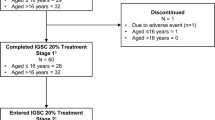Abstract
Published studies of the metabolism of human IgG using trace amounts of radiolabeled IgG demonstrated that the elimination of native IgG followed first-order kinetics but that the half-life of IgG was shortest in patients with the highest serum concentrations of IgG. To evaluate the effect of increasing the serum concentration of IgG on the metabolism of IgG, we determined the half-life and clearance of IgG and tetanus antibody in 16 patients with severe primary humoral immunodeficiency diseases while they received several doses of intravenous γ-globulin (IVIG). Each patient received 100 mg/kg of IVIG each month and the half-life and clearance of IVIG were determined by following the decline in the serum IgG concentration. The dose of IVIG was adjusted to give a minimum IgG level of 200 mg/dl and the half-life was reevaluated. The dose was again adjusted to give minimum concentrations of 450 mg/dl and two additional studies were performed. Mean doses of IVIG infused increased from 100 to 346 mg/kg. The mean trough serum IgG concentration was 191 mg/dl on the standard dose and increased to 427 mg/dl at the highest dose. The serum half-lives of IgG were highly variable, ranging from 22 to 96 days. The mean decreased from 43 days in the first to 33 days in the third and fourth studies, and the clearances of IgG increased from 1.8339 to 2.4302 mg/kg/day, but the differences were not statistically significant. Patients with the highest serum IgG concentrations tended to have the longest half-lives, suggesting that intrinsic IgG production might falsely prolong the calculated half-life of IgG. However, it was possible to determine the half-life in these patients by measuring the decline in tetanus antibody. The half-life measured by this technique in the third and fourth studies was 27 and 36 days and the clearances were 2.988 and 3.648 ml/kg/day. Knowledge of the metabolism of IgG in these patients may lead to more appropriate guidelines for determination of dosage.
Similar content being viewed by others
References
Waldmann T, Strober W: Metabolism of immunoglobulins. Prog Allergy 13:1–110, 1969
Schiff R, Rudd C, Johnson R, Buckley RH: Use of a new chemically-modified intravenous IgG preparation in severe primary humoral immunodeficiency: Clinical efficacy and attempts to individualize dosage. Clin Immunol Immunopathol 30:13–23, 1984
Stephan W: Undegraded human immunoglobulin for intravenous use. Vox Sang 28:422–437, 1975
Morell A, Schurch B, Ryser D, Hofer F, Skvaril F, Barandun S:In vivo behavior of gamma globulin preparations. Vox Sang 38:272–283, 1982
Buckley RH, Dees S, O'Fallon W: Serum immunoglobulins I. Levels in normal children and in uncomplicated childhood allergy. Pediatrics 41:600–611, 1967
Wells JV, Penny R: Survival studies on a commercial preparation of intravenous human gammaglobulin labelled with131I. Aust Ann Med 18:271–276, 1969
Andersen S: Metabolism of Human Gamma Globulin (γ-Globulin). Oxford, Blackwell Scientific, 1964
Remington RD, Schork MA. Statistics with Applications to the Biological Sciences. Englewood Cliffs, NJ Prentice Hall, 1970, pp 260–264
Shargel L, Yu AB: Applied Biopharmaceutics and Pharmacokinetics. Norwalk CT, Appleton-Century-Crofts, 1980
Powell JR, Vozeh S, Hopewell P, Costello J, Sheiner LB, Riegelman S: Theophylline disposition in acutely ill hospitalized patients. Am Rev Resp Dis 118:229–238, 1978
Ammann A, Ashman R, Buckley RH, Hardie WR, Krantman HJ, Nelson J, Ochs H, Stiehm ER, Tiller T, Wara DW, Wedgwood R: Use of intravenous γ-globulin in antibody immunodeficiency. Results of a multicenter controlled trial. Clin Immunol Immunopathol 22:60–67, 1982
Wells J, Fudenberg H: Metabolism of radio-iodinated IgG in patients with abnormal serum IgG levels II. Hypogammaglobulinemia. Clin Exp Immunol 9:775–783, 1971
Kornhuber B: Antikorpertiter nach intravenoser gammaglobulintherapie. Klin Wschr 51:135–136, 1973
Pirofsky B, Campbell S, Montanaro A: Individual patient variation in the kinetics of intravenous immune globulin administration. J Clin Immunol 2 (Suppl 2):7–14, 1982
Fahey J, Robinson A: Factors controlling serum γ-globulin concentration. J Exp Med 118:845–868, 1963
Sell S: Evidence for species' differences in the effect of serum γ-globulin concentration in γ-globulin catabolism. J Exp Med 120:967–986, 1964
Koblet Von H, Diggelmann H, Barandun S, Kaser H, Riva G: γ-globulin-stoffwechsel bei A- und hypogammaglobulinamie turnover-untersuchungen mit γ-globulin-I131. Helv Med Acta 31:618–622, 1964
Karitzky von D, Renz H: Erfahrungen mit der Intraglobintherapie bei dysgammaglobulinamie typ I. Biotest-Mitteilungen. Heft 35:11, 1974
Pirofsky B: Intravenous immune globulin therapy in hypogammaglobulinemia. Am J Med 76(3A):53–60, 1984
Buckley RH: γ-Globulin replacement. Clinics in Immunol Allergy 5:141–158, 1985
Ochs HD, Fischer SH, Wedgwood RJ, Wara DW, Cowan MJ, Ammann AJ, Saxon A, Budinger MD, Allred RU, Rousell RH: Comparison of high-dose intravenous immunoglobulin therapy in patients with primary immunodeficiency diseases. Am J Med 76(3A):78–82, 1984
Author information
Authors and Affiliations
Rights and permissions
About this article
Cite this article
Schiff, R.I., Rudd, C. Alterations in the half-life and clearance of IgG during therapy with intravenous γ-globulin in 16 patients with severe primary humoral immunodeficiency. J Clin Immunol 6, 256–264 (1986). https://doi.org/10.1007/BF00918706
Issue Date:
DOI: https://doi.org/10.1007/BF00918706




